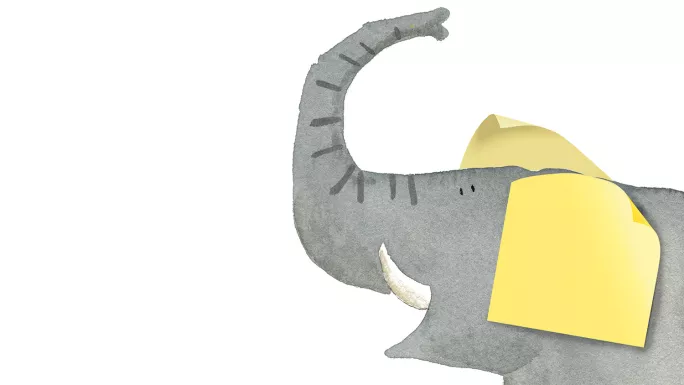- Home
- Memories are made of this
Memories are made of this

Look at the following characters for as long as you like and then try to copy them onto a piece of paper without looking back at them.
ЖӘШІК
Most people can’t do it. In fact, most people in Britain would probably need to copy it one character at a time and maybe even one stroke at a time. You might then need to look back at it a dozen times to be sure you had it right.
If on the other hand you have learned some Russian, four of the symbols would be immediately familiar, so perhaps a couple of glances would do.
If you can read Kazakh, you would need to look at it only once, because you would recognise it as the Kazakh word for “box”.
This might seem like a trivial observation, but it reveals something rather profound about the way our brains work - and about memory in particular. More importantly, a failure in schools to take these realities into account means that much of what happens in our classrooms is less effective than it could be.
Educated guesses
Of course, no one knows exactly how the human brain works, but over the years scientists have developed a number of models that seem to describe pretty well how our brains do what they do; importantly, they predict quite accurately what humans find hard and what they find easy.
At the outset, I should be clear that whether the models are right or not is unimportant. To paraphrase British statistician George EP Box, “all models are wrong, but some are useful”.

What makes a model valuable is not how accurate it is - any model can be made more accurate by making it more complex - but rather the trade-off between simplicity and power. This is particularly important when we look at the human brain, which is probably the most complex thing in the universe.
Findings from neuroscience do help us understand what is going on inside the brain when students learn and, in years to come, neuroscientists might find particular structures in our brains that correspond to particular parts of the models we use to talk about learning. But whether they do or do not should not change what teachers do. Teachers need to focus on doing the things that result in the maximum learning for their students.
An analogy might be helpful here. When learning to drive in icy conditions, inexperienced drivers are told to “steer into the skid”. This is hard to do because the natural reaction to a skid is to try to correct it by steering in the opposite direction, but steering into the skid is definitely the right thing to do. Now, we could analyse the steering mechanism of a car, the laws of friction, the properties of the tyres and so on, and while this might give us some understanding of why steering into the skid is the right thing to do, it does not change the advice.
In the same way, over the next 50 years, neuroscience is likely to provide us with plausible explanations about why the models developed by cognitive scientists are right and neuroscience might even provide some clues about new things to try to improve learning. But the evidence that these are, or are not, good things to do will come from experiments in which teachers and students try out new ideas and we examine their effect on students’ learning - in other words, from cognitive science, not neuroscience.
What we need to know about short- and long-term memory
Perhaps the most useful model of how our brains work, especially in terms of the trade-off between power and simplicity, is the idea that there are two kinds of memory: short-term or “working” memory, and long-term memory.
Short-term memory is where we hold things that we are working on right now, such as when we look up a phone number and hold it in our heads while we are dialing the number. Long-term memory is where we store things such as our home telephone numbers and family dates of birth.
The important point - the point that in fact should guide the whole of education - is that short-term memory is limited in both capacity and duration. We can’t hold very much in short-term memory and what little we can hold doesn’t stay there for very long. Most adults can, if they look up a seven-digit phone number, remember that number for long enough to key the number into a phone, but 10 minutes later, the number is often difficult to recall. Moreover, there seems to be little that we can do to increase the capacity of short-term memory.
However, long-term memory is, for all intents and purposes, infinite, or at least we do not seem to be anywhere close to finding its limits.
The good news is that long-term memory and short-term memory work together pretty seamlessly. So although we can’t increase the power of short-term memory, we can make our brains much more powerful by increasing the contents of long-term memory.
As an example, consider the following telephone number: 0113 246 0531.
To remember this number involves remembering 11 digits. But if I know that the place I am calling is in Leeds and I know that the code for Leeds is 0113, then I only have to remember eight things: the fact that the number is in Leeds, and the seven digits of the number that come after the 0113.
The number becomes even easier to remember if I notice the number’s pattern of increasing consecutive even numbers and decreasing consecutive odd numbers. The contents of long-term memory makes the use of short-term memory more powerful.
This is why the idea that knowledge is unimportant because “you can always Google it” - a comment now so familiar in education commentaries - is so profoundly wrong. Long-term memory works seamlessly with short-term memory, but looking things up requires valuable space in short-term memory, reducing the amount of such memory available for thinking (and even that is only possible if you know what you need to look up).
If you have to look things up, your brain will simply be less powerful than if you know the same things. And this is also why it makes little sense to separate content from skill in education: what separates experts from novices are differences in long-term memory - experts know more and their knowledge is better organised.
How what we know about memory connects to teaching
The purpose of school - indeed, the purpose of all learning - is to change long-term memory. The problem is that much of what we do in school takes little account of what we know about how memory works.
In particular, our students would almost certainly learn more if we used three fairly well-established facts about memory in the design of our teaching.
1. Students can be intensively engaged in something with little or no resulting change in long-term memory
It is obvious that with poorly designed classroom activities, students may not learn what we want them to learn, such as when a history lesson involves designing costumes for historical characters rather than grappling with cause and effect, chronology and reconciling conflicting sources.
What is less obvious is that students can be intensively involved in highly relevant activities and still learn little. This was first researched in depth by Australian psychologist John Sweller. He gave maths undergraduates mathematical problems to work on and while the students correctly solved a number of problems, they did not notice that all the problems shared a common solution method. It is possible for students to solve problems successfully without getting any better at solving problems.
For novices, going through worked examples can often be more effective than solving problems unaided, because the “cognitive load” involved in solving problems can overwhelm short-term memory, so that little learning takes place. While students do remember more of what they have to think hard about, there is a limit, beyond which learning is actually reduced.
As students gain expertise, it makes sense to reduce the support given, for example, by asking them to fill in missing steps and at a later stage solve entire problems. At this stage, while cognitive load theory offers a lot of advice about how to design effective teaching, substantial teacher judgement is needed to determine how much structure should be provided for students. But we definitely know that just having students think hard in classrooms might not be the best way to learn.

2. What matters for long-term learning is not retrieval strength but storage strength - how well something has been learned
The second insight comes from the work of Robert Bjork, distinguished professor of psychology at the University of California, Los Angeles, on memory. Most people think that when we learn something, such as a telephone number or an address, unless the information is used regularly, then the memory fades and is eventually lost (this model is called the “theory of disuse”). But it seems that once something has been learned, the memory is never really lost. Many people cannot recall the postcode for their childhood home, and assume that it has been forgotten. However, if they were presented with a list of five postcodes, they would immediately be able to recognise the one that was correct.
The memory is still there; what’s hard is retrieving it. Bjork’s “new theory of disuse” distinguishes between how well something has been learned (“storage strength”) and how easy something is to recall at a given moment in time (“retrieval strength”).
This distinction is important because what matters for long-term learning is not retrieval strength, but storage strength - how well something has been learned.
The fact that someone can remember something right now could mean that it is something they know really well (high storage strength), but it might just mean that the retrieval strength for that item happens to be high at that moment.
To be sure that something has been learned, we should be finding out what students know some time after teaching. In other words, we should be testing our students on what they have been learning at frequent, regular intervals.
Frequent testing has an additional benefit, which is that successfully retrieving something from memory increases storage strength, and the harder something is to retrieve, the greater the increase in storage strength. The best time to do practice testing is just as students are beginning to forget things.
3. The more confident someone is that an incorrect answer is, in fact, correct, the more likely they are not to repeat the error if they are corrected
The third insight comes from the work of Janet Metcalfe, professor of psychology at Columbia University and others on learning and feedback. It used to be assumed that the more confident a person was about the correctness of an answer they had given in a test, the harder it would be to change their mind if the answer was in fact incorrect. But it turns out that the opposite is true. The more confident someone is that an incorrect answer is correct, the more likely they are not to repeat the error if they are corrected.
Or, to use the psychological jargon, high-confidence errors are hypercorrected. Every teacher I have ever met says that it is OK to make mistakes, but very few teachers believe that making mistakes - and being corrected - is better for long-term learning than not making mistakes.
Lots of practice testing, with feedback on errors, is therefore likely to substantially increase students’ long-term recall of what they are learning.
The problem, of course, is that students do not like being tested. The way out of this impasse is to realise that students do not gain any additional benefit from practice testing when a teacher records a score in a markbook. The benefits of testing come from the retrieval practice that students get when they take the test, and the hypercorrection effect when they find out answers they thought were correct were in fact incorrect. In other words, the best person to mark a test is the person who just took it.
Application of the science
There are, of course, other things that follow from this simple model of human memory, but the evidence that they will improve learning in real classrooms is not as clear cut as it is for cognitive load theory, the new theory of disuse and the hypercorrection effect. Moreover, these other theories are somewhat more complex, so are more difficult to apply in real classroom settings.
Learning will always be a somewhat mysterious process that happens inside the heads of our students when they are in our classrooms. But by understanding the distinction between short-term and long-term memory, teachers can think about how to design and present classroom activities in ways that limit the cognitive load for students. Then, with regular practice testing, where students correct their own work and do not even have to tell the teacher how well they did, we can improve how much of what happens in classrooms our students remember - which is, after all, the whole point.
Dylan Wiliam is emeritus professor of educational assessment at University College London. For more on John Sweller and cognitive load theory, see bit.ly/SwellerResearch. Robert Bjork outlines his new theory of disuse at bit.ly/TheoryOfDisuse
Want to keep up with the latest education news and opinion? Follow Tes on Twitter and Instagram, and like Tes on Facebook
Keep reading for just £1 per month
You've reached your limit of free articles this month. Subscribe for £1 per month for three months and get:
- Unlimited access to all Tes magazine content
- Exclusive subscriber-only stories
- Award-winning email newsletters



